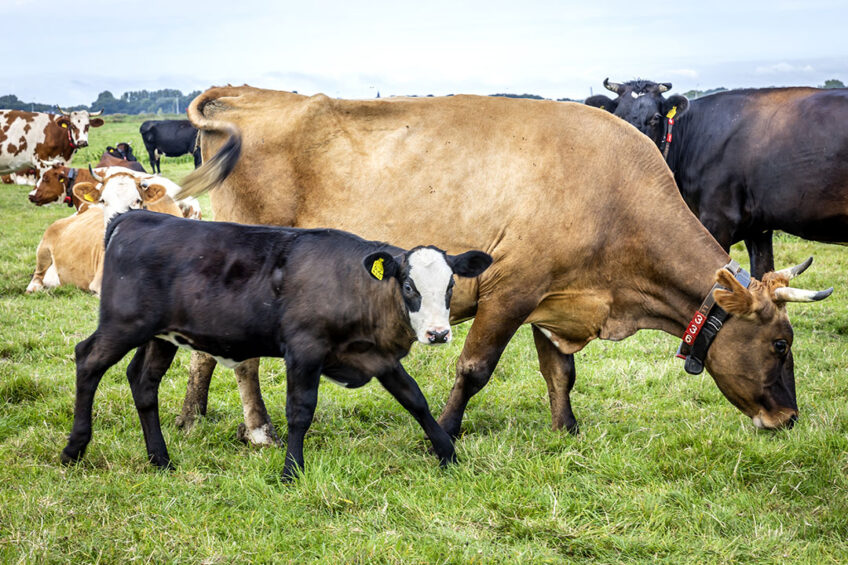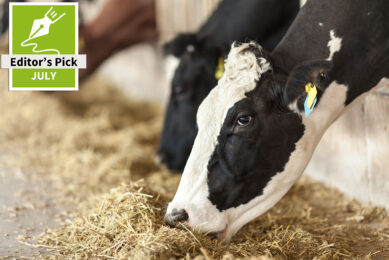5 tips to improve calf health through pre-calving nutrition

This article lists 5 nutritional tips to improve calf health, survivability, long-term health, and overall breeding and production performance.
During the pre-calving period, the last 60-90 days of gestation, the foetus grows rapidly. In addition, during late gestation considerable tissue growth including the uterus, and placenta and the increase in surrounding foetal fluids enhance energy requirements of cows by 20% and protein needs by 10%. Nutrition during late gestation impacts the calf’s survivability, long-term health, and overall breeding and production performance. To accommodate the additional growth without losing body condition, special attention must be paid to cow nutrition during pre-calving period to support desired weight gain.
 Providing sufficient energy levels can make a difference
Providing sufficient energy levels can make a difference
Dairy cow energy requirement during late gestation is greater than that of non-pregnant cows. In addition, when cold, windy, or wet weather is extended more than 5 days, cow energy requirements can increase by 10-20%; therefore, additional energy supplements may be needed. Providing enough energy for cows with a body condition score lower than 6 in the final month of gestation will increase milk yield, improve colostrum quality, and provide the immunity support the calf needs.
 Protein supplementation is critical
Protein supplementation is critical
Providing approximately 42% crude protein for cows grazing winter range during the pre-calving period increases the body condition score, enhances the number of calves weaned, augments hot carcass weights, improves calf health, and calves’ immune system following birth. In addition, supplementing protein during pre-calving when feeding low-quality roughage with 8-10% crude protein improves progeny performance, and herd performance. During the pre-calving period, protein requirements for a 1100-lb cow are about 1-1.5 lbs. per day which can be met with 30 lbs. of 8% protein grass hay or 15 lbs. of 16% alfalfa hay.
 Minerals are the foundation of a solid nutrition
Minerals are the foundation of a solid nutrition
Forages are the basis of cattle nutrition; however, they don’t always meet the nutrient requirements of cows and their offspring. As the foetus grows, the demands for calcium and phosphorus increases. In addition, proper foetal body and immune system development requires high levels of copper, selenium, and zinc. Investing in year-round organic and inorganic trace mineral supplements for cows maintain proper body condition score throughout the year and set up the cow for long-term success. It is recommended to begin supplementation or feeding minerals 30-45 days before calving and to continue through breeding.
 Vitamins are the key for calf development
Vitamins are the key for calf development
Most vitamins are synthesised in the rumen, except Vitamin A and E which can be derived from consuming green forages. Vitamin A and E are needed for immune system development and foetal growth. When green forage is not available, pregnant cows and heifers should be supplemented with 30,000-100,000 IU per head per day of Vitamin A and 50-100 IU per head per day of Vitamin E. Studies showed that higher vitamin supplementation rates do not appear to be risky from a toxicologic standpoint. Insufficient supplementation of vitamin A and E when grazing low quality forages leads to cows depleting their liver stores of these vitamins. Furthermore, in calves, vitamin A and E imbalance causes stillbirths, blindness, and white muscle disease.
 Feeding time affects when calves are born
Feeding time affects when calves are born
During calving season, the time of day that cows are fed impacts the time when calves are born. Feeding cows later in the day and evening will increase the number of calves born during daylight hours, when it is easier for livestock producers to watch them more closely. A method developed by Gus Konefal, a Manitoba Hereford breeder, involves feeding twice daily, once at 11:00 to 12:00, and again at 21:30 to 22:00 starting 1 month before the first calf is born and continuing for the duration of the calving season. It was reported that, using this method, 80% of the cows calved between 7:00 and 19:00 hours
Concluding remarks
Nutrition during pre-calving period impacts both dairy cow and calf; therefore, it is essential to pay attention to energy, protein, minerals, vitamins, and feeding time of the cows to improve calves’ health. Although, before deciding to implement a supplementation programme, it is essential to collect an accurate feed sample and to analyse it to ensure that critical nutrient requirements are met without spending too much on feed costs.
* References are available upon request.











